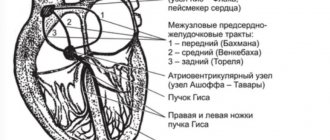In order for the prevention of vascular complications to be effective, everyone needs to know the general symptoms of cardiovascular diseases:
- Burning, sharp, dull or aching pain in the chest . More often occurs during physical, emotional stress, and climate change. Sometimes it radiates to other parts of the body (for example, to the left arm, neck, back).
- Heart rhythm disturbance . Tachycardia (rapid heartbeat) or bradycardia (decreased heart rate) is observed.
- Shortness of breath occurs during physical activity . Indicates excessive stress on the heart muscles and vascular system.
- Swelling . It is observed in the face, arms, lower extremities, and is sometimes accompanied by spider veins on the legs. Swelling usually appears in the evening. They indicate stagnant processes in the vascular system. Prevention of spider veins on the legs should be comprehensive: hardening, compression garments, etc.
- Dizziness and headache may indicate insufficient oxygen supply to the brain. Prevention of vascular diseases of the brain in this case includes taking vasodilating medications that improve blood circulation, for example, Papaverine, Eufillin.
- Changes in blood pressure, weakness, nausea.
Primary prevention of cardiovascular diseases
Primary prevention of heart disease in men and women is aimed at preventing pathology and creating optimal conditions for the normal functioning of the cardiovascular system. The following factors increase the risk of disease:
- high blood cholesterol;
- increased blood pressure;
- smoking, alcohol;
- poor physical activity;
- excess weight;
- excessive physical and psychological stress.
To minimize the likelihood of developing cardiovascular diseases, the above factors should be eliminated or limited (quit smoking, alcohol, monitor excess weight, etc.).
Diabetes mellitus is an independent risk factor. The incidence of cardiovascular pathologies in patients with diabetes occurs 4-6 times more often than in the general population. Therefore, prevention in such individuals should be mandatory and be based on the correction of arterial hypertension, hypoglycemia, dyslipidemia, and control of the rheological properties of the blood.
Primary prevention of cardiovascular diseases includes the following diagnostic methods:
- laboratory tests (genetic tests, blood tests for biochemistry);
- instrumental diagnostics (ECG, ultrasound, ultrasound, ABPM, MRI or CT, etc.).
It is recommended to take a referral for a preventive examination from a general practitioner; he will tell you which diagnosis is best to choose, taking into account the patient’s complaints and medical history.
Climatotherapy will help strengthen the cardiovascular system. Dosed use of climatic conditions for health purposes has training, hardening and rehabilitation effects on blood vessels and the heart:
- gelotherapy (sunbathing);
- aerotherapy (air therapy);
- speleotherapy (cave treatment);
- thalassotherapy (the totality of the influence of marine factors on the body: mud, water, algae, etc.).
The nurse's role in the prevention of cardiovascular disease is important. Nurses help:
- overcome barriers for patients to prevent cardiovascular diseases - reluctance to undergo treatment, distrust of traditional medicine, etc.;
- assess the level of knowledge deficit about the prevention and treatment of vascular pathologies in patients;
- conduct surveys of citizens at risk.
In addition, the medical staff carries out:
- conversations on the prevention of cardiovascular diseases;
- distribution of leaflets, leaflets and booklets on the prevention of vascular pathologies;
- screening programs for the prevention of cardiovascular diseases;
- hotline for the prevention and treatment of vascular diseases.
The importance of a healthy lifestyle for the prevention of cardiovascular diseases
A healthy lifestyle plays a decisive role in the primary prevention of cardiovascular diseases, which consists of:
- proper nutrition;
- regular moderate physical activity;
- reducing stress;
- giving up alcohol and smoking.
The role of nutrition in the prevention of cardiovascular diseases
The abundance of fatty, spicy, salty and smoked foods in the diet causes excess weight, high cholesterol in the blood and, as a result, disruption of the cardiovascular system. To prevent cardiovascular diseases, it is not necessary to follow a strict diet; it is enough to limit unhealthy foods and include the following foods in your diet:
- Vegetables, greens, fruits, berries (blueberries, broccoli, pumpkin, pomegranate, spinach, avocado, tomatoes, garlic, olives, etc.).
- Fish (mackerel, trout, salmon, tuna, herring, sardines, etc.).
- Black chocolate.
- Oatmeal, bran, legumes.
- Olive, corn, linseed oil.
- Nuts, dried apricots, almonds.
It is recommended to cook food by steaming, boiling, stewing. Take food often, in small portions. All this will help reduce cholesterol levels by 10-15%, which will improve the condition of blood vessels and prevent atherosclerosis.
Physical education in the prevention of cardiovascular diseases
Physical education is an integral part of the prevention of cardiovascular diseases. To strengthen the cardiovascular system, improve the body's adaptive abilities and increase the immune system's resistance to adverse factors, physical activity is recommended.
Cardio exercises will help with this to prevent cardiovascular diseases. They speed up the heart rate, saturate the body with oxygen, burn fat deposits, and strengthen the cardiovascular system. These include:
- run;
- intense walking;
- stepping;
- bike;
- jump rope, etc.
If you can’t go to the gym, get off a few stops earlier every day and walk home instead of using the elevator.
Excessively intense physical activity can be harmful to health, especially in the presence of hidden CVDs. Therefore, the prevention of cardiovascular diseases in athletes should be based on regular laboratory and instrumental examinations of blood vessels and the heart (ultrasound, CT, ultrasound, blood tests for biochemistry, etc.).
Primary prevention of heart disease
Prevention of a healthy heart and blood vessels involves:
- avoid factors that have a detrimental effect on the system - active and passive smoking, taking narcotic substances;
- control your weight. Fat deposition in the waist area is especially dangerous.
A healthy diet and physical activity can help keep you fit and keep your heart healthy.
Nutrition
To prevent heart and vascular diseases, a transition to a healthy diet is necessary. It is recommended not to overeat, eat 4 times a day. It is advisable to have dinner no later than three hours before bedtime. You should pay attention to the dishes and products you eat:
- limit caffeinated drinks, sugar, sweets, flour products;
- palm, coconut, ghee oils are harmful to the muscle tissue of the heart;
- avoid sausages, canned food, pickles;
- reduce your consumption of alcoholic beverages;
- Replace fatty meats with lean ones: rabbit, turkey, chicken;
- The recommended amount of salt is 5 g per day;
- introduce olive, sesame, and flax oils into your diet;
- Fresh fruits and vegetables, herbs must be present on the table;
- Dried apricots and raisins are very beneficial for heart health;
- Replace mayonnaise in salads with vegetable oil;
- eat a handful of nuts daily;
- include different cereals in the menu, eat bread made from wholemeal flour;
- sea fish and seafood are rich in healthy omega-3 fatty acids;
- Fermented milk products will provide the body with the calcium it needs.
Bake, boil, steam dishes more often, avoiding fried foods as much as possible in order to prevent cholesterol plaques on the blood vessels of the heart. Drink at least two liters of fluid per day. It is better if it is green or herbal tea, juices, compotes, mineral water. Carbonated drinks are best avoided as they help remove calcium from the body.
Physical exercise
An inactive lifestyle, as well as increased physical activity, threatens the development of health problems. Prevention of heart and vascular diseases includes mandatory movement. The following types of activities are recommended:
- bicycle rides;
- swimming;
- skiing;
- moderate gardening work;
- race walking;
- physiotherapy.
Activity should be fun and not cause overwork. This is especially true for the prevention of heart disease in older people. Excessive physical activity exhausts the cardiovascular system and is harmful to health.
Secondary prevention of cardiovascular diseases
Secondary prevention of cardiovascular diseases consists of timely detection of the disease, preventing the progression of an existing disease, disability and improving the patient’s condition. Most diseases require a separate approach.
For example, secondary prevention of heart attack includes timely medical care. If a person once had a heart attack, then in the first aid kit for prevention it is necessary to have nitroglycerin or aspirin to prevent sudden cardiac death. In addition, secondary prevention also includes:
- control of blood pressure and cholesterol levels;
- weight normalization;
- to give up smoking;
- physical exercise.
Secondary prevention of cardiac asthma (acute shortness of breath, apnea, facial cyanosis, swelling of the neck veins, tachycardia, cough, high blood pressure) includes taking medications:
- nitroglycerin to dilate blood vessels and improve blood flow;
- diuretics to lower blood pressure;
- narcotic analgesics for severe pain (Omnopon, Morphine).
As well as oxygen inhalation, application of tourniquets to the legs and arms (to create artificial stagnation of blood).
Secondary prevention of vascular dementia (cognitive impairment, epileptic seizures, walking impairment, instability, urination disorders, slow reaction, narrowing the range of interests, etc.) consists of taking drugs from different groups:
- neurotrophic (Cerebrolysin);
- nootropics (Piracetam);
- antioxidants (vitamins E, C, flavonoids);
- neuropeptides (Actovegin, etc.).
Secondary prevention of vegetative-vascular dystonia (panic attacks, changes in blood pressure, lack of oxygen, facial redness or pallor, muscle stiffness, etc.) includes taking sedatives (Fitosed, Barboval), drugs that improve metabolism in brain tissue (Cavinton); stabilization of emotional health (psychological trainings, auto-trainings, etc.).
European recommendations for the prevention of cardiovascular diseases:
- monitor your blood pressure (systolic blood pressure below 140 mmHg;
- stop using tobacco products;
- walk about 3 km a day or do 30 minutes of moderate physical activity;
- maintain blood cholesterol levels no higher than 5 mmol/l;
- eat foods low in cholesterol, salt and sodium;
- Eat at least 5 fruits and vegetables daily.
Secondary prevention of coronary artery disease
Patients with an established diagnosis of ischemic
heart disease must especially carefully observe measures to prevent the further
development
of the pathology and its complications - unstable angina, chronic heart failure, myocardial infarction.
A set of secondary prevention measures
- Avoiding any nervous tension or learning self-control techniques that will help reduce the risks of stress spasm of the coronary arteries.
- Therapeutic physical education (therapeutic physical education). The initial level of activity and the dynamics of its growth are determined by the doctor based on body weight, level of fitness, age and severity diseases
.
- Reception appointments medications
.
After assessing the severity condition
, the cardiologist prescribes statins (lowering low-density lipoprotein levels), antiarrhythmics, antihypertensives and blood thinners. - Surgical treatment methods in cases where the disease progresses rapidly despite the implementation of the above measures prevention
.
Prevention of cardiovascular diseases in children
Prevention of diseases of the cardiovascular system in children is to improve the body's defenses. Various vitamin complexes will help strengthen the immune system:
- Directs – helps stabilize blood pressure, normalize cholesterol in the blood, improve heart function;
- Duovit – improves cellular metabolism, regulates the tone of the heart muscle, strengthens blood vessels;
- Doppelhertz Kinder - improves the functioning of the heart muscle, reduces the likelihood of diseases.
Other measures to prevent cardiovascular disease in children:
- Balanced diet.
- Moderate physical activity.
- Body weight control.
- Limiting negative emotions.
When to start prevention of coronary artery disease
Reasons for development
diseases can be divided into three categories.
Persons included in at least one of these groups should especially carefully monitor their health
and regularly see a doctor.
Risk factors for developing coronary artery disease
- Biological: elderly and advanced age, gender of the person (men are more predisposed to ischemia).
- Biochemical and physiological: dyslipidemia (impaired fat metabolism), hypertension, obesity, diabetes mellitus and impaired glucose tolerance.
- Behavioral: smoking, addiction to alcohol, poor diet, physical inactivity, exposure to stress.
Most often, early ischemic
changes in blood vessels appear due to behavioral factors - poor nutrition, bad habits and physical inactivity (decreased physical activity).
Therefore, the earlier a set of
special preventive measures is started, the greater the likelihood of reducing the risk of serious pathology of the heart and blood vessels to a minimum.
The most reliable prevention of ischemia is a healthy lifestyle
Primary prevention of coronary artery disease
is a list of rules, the totality of which is called a healthy lifestyle. They are recommended to be followed not only by people at risk, but by any person. These are simple and effective measures to help avoid problems with the heart and blood vessels.
Secondary
called
prevention
, which is aimed at reducing the risk of
developing
complications of an existing disease. These measures should be implemented from the moment of diagnosis, regardless of age.
Particularly carefully and to the primary
, and
secondary prevention
should be applied to people over 40 years of age - as part of monitoring the condition of the cardiovascular system.
Prevention of heart disease with folk remedies
You can improve your cardiovascular system using folk remedies. Plants such as mint and fennel have a vasodilating and antispasmodic effect. Brew the fruits of these plants as tea and take once a day.
Motherwort, lemon balm, and hawthorn have sedative (calming) properties. Pour 1 tbsp. ground fruits of the plant with a glass of boiling water and take it as a tea decoction once a day.
Green tea will help reduce cholesterol levels in the blood. Its use also maintains the elasticity of blood vessels, tones the heart muscles and stops the overall aging of the body. To prevent cardiovascular diseases, it is recommended to take it in dosage, no more than 2 times a day, because green tea is rich in caffeine, which can cause insomnia and excessive excitability of the nervous system.
Memo for the population on the prevention of cardiovascular diseases
- Balanced diet. Reduce your intake of fried foods, fatty foods, coffee, salt and sugar. Add as much fresh vegetables and fruits, sea fish, lean poultry, and whole grain cereals as possible.
- Body weight control. If you become overweight, stick to a low-calorie diet and exercise.
- Fighting physical inactivity. Play sports under the supervision of experienced instructors, walk in the park or forest. If possible, avoid traveling by car and use the elevator less often.
- Rejection of bad habits. Get rid of alcohol, tobacco and drug addiction on your own or with the help of special treatment.
- Protection from stress. Respond adequately to problems and minor issues, communicate more with friends, engage in your favorite hobby, and maintain a work-rest schedule. If necessary, use herbal sedatives.
- Self-monitoring of blood pressure. Measure your blood pressure regularly if you are at risk for developing cardiovascular disease. If alarming symptoms occur, take prescribed antihypertensive medications.
- Regular preventive examinations. Visit your doctor in a timely manner, undergo preventive examinations and take the necessary tests.
- Cholesterol control. If you are over 30 years old, get a blood test every year to check your cholesterol levels.
- Constant control of blood sugar. Upon reaching 40-45 years old, take a blood sugar test every year.
- Prophylactic use of blood thinning medications. Patients at risk should take blood thinners prescribed by their cardiologist.
Correction of main risk factors from the point of view of new European recommendations
Arterial hypertension
A number of epidemiological studies have identified elevated blood pressure as a risk factor for the development of coronary artery disease, heart failure, cerebrovascular disease, renal failure, and, more recently, atrial fibrillation. It has also been shown that blood pressure levels negatively correlate with cognitive function, and hypertension is associated with an increased incidence of dementia in patients. Research data have shown that death from ischemic heart disease and stroke increases linearly and gradually as SBP levels increase above 115 mmHg. and diastolic blood pressure (DBP) above 75 mm Hg. [7, 25].
Some studies have shown that high pulse pressure (the difference between SBP and DBP) may be a predictor of adverse cardiovascular outcomes, but a meta-analysis of the data showed that the level of SBP and DBP is more important. This meta-analysis also confirmed the significance of the increase in pulse pressure after age 55 years [2].
Individuals with elevated BP often have other risk factors for CVD (diabetes, insulin resistance, dyslipidemia) and end organ damage. Because risk factors can interact, the overall risk in people with hypertension is increased, even if the level is low or moderate.
Target blood pressure values for all patients with hypertension are SBP less than 140 mmHg. and DBP less than 90 mm Hg, however, it should be borne in mind that such a decrease in blood pressure has not been studied in elderly patients. Previous recommendations of a target SBP of less than 130 mm Hg. in patients with diabetes mellitus (DM) are not confirmed in studies [2].
In the treatment of patients with hypertension, an important role is played by controlling body weight, limiting salt intake to 5 g per day, reducing alcohol consumption and increasing physical activity.
Drugs that lower blood pressure and significantly reduce morbidity and mortality include thiazide and thiazide-like diuretics, beta-blockers, calcium antagonists, ACE inhibitors and angiotensin receptor blockers. Each of the groups of drugs is indicated for both primary and long-term therapy, alone or in combination with other drugs [10]. Evidence of the effectiveness of other classes of drugs is limited. Aldosterone antagonists and α-blockers reduce blood pressure, but there is no evidence that they affect mortality. These drugs can be used in combination with other drugs. The renin receptor inhibitor drug Aliskiren is effective in lowering blood pressure [26], but studies examining the effect of this drug on morbidity and mortality have not yet been completed.
Treatment of patients with diabetes mellitus
Intensive therapy for hyperglycemia in diabetes reduces the risk of microvascular complications, as well as CVD, but to a lesser extent. Intensive correction of blood pressure in patients with diabetes to target values reduces the risk of macro- and microvascular outcomes, but achieving the goal requires the prescription of several antihypertensive drugs [11].
Currently, the target value of glycated hemoglobin is recognized to be an HbA1c level of 7.0% [2], but the question of the optimal way to achieve its target level without excessive weight gain or hypoglycemia still remains open. Research is currently underway to evaluate new antidiabetic drugs with a low risk of hypoglycemia, such as dipeptidyl peptidase-4 inhibitors, which do not affect body weight, and glucagon-like peptide-1 receptor agonists, which promote weight loss [2]. However, it is separately noted that in the presence of newly diagnosed diabetes, patients require more stringent control of glycated hemoglobin levels (HbA1c ≤6.1%) [2].
Blood lipids
Elevated levels of total cholesterol and low-density lipoprotein (LDL) in the blood are one of the main risk factors for the development of CVD. LDL levels are recommended as the initial lipid profile for risk assessment and as a target for therapy. Independent predictors of CVD also include hypertriglyceridemia and low high-density lipoprotein (HDL) levels. HDL levels are also recommended for risk assessment, but not as a target for treatment [1, 11]. In the blood plasma, cholesterol and triglycerides are associated with various proteins (apoproteins) and form lipoproteins. LDL, especially small ones, are atherogenic. Chylomicrons and very low-density lipoproteins (VLDL) are not atherogenic, but their high concentrations can lead to pancreatitis. HDL does not cause atherosclerosis, but, on the contrary, has antiatherogenic properties [27]. The optimal values of blood plasma lipids are presented in table. 3
.
First of all, correction of lipid metabolism should be carried out in patients with existing CVD, regardless of their lipid levels. The target LDL level in very high-risk patients is 1.8 mmol/L (<70 mg/dL) or a reduction of at least 50% when the target value cannot be achieved. In high-risk patients, the target LDL level is 2.5 mmol/l (<100 mg/dl); in moderate-risk patients, it is 3.0 mmol/l (<115 mg/dl) [2].
If non-drug therapy is ineffective, as well as with severe hyperlipidemia, drugs that reduce blood cholesterol are used. The main classes of lipid-lowering drugs are as follows: statins, bile acid sequestrants, fibrates, nicotinic acid and its derivatives.
The most common drugs are statins. Statins are prescribed in a daily dose of 10-20 to 80 mg once in the evening with meals. When treating with statins, it is necessary to monitor such biochemical blood parameters as alanine aminotransferase, aspartate aminotransferase, creatine phosphokinase (CPK). If blood enzymes increase by 3 times or more compared to normal values, the need to continue statin therapy should be considered. An increase in CK blood levels may be asymptomatic, or may be accompanied by myalgia and even signs of rhabdomyolysis [1, 2].
Fibric acid derivatives are used to treat hyperlipidemias with high triglyceride levels. The group of bile acid sequestrants includes cholestyramine and colestipol, which are often used as additional drugs to statins or fibrates, but they can be used independently if these two groups of drugs are intolerant.
Nicotinic acid is a water-soluble B vitamin (vitamin PP). It suppresses lipolysis of adipose tissue, reduces the influx of free fatty acids into the liver, resulting in a significant reduction in the production of triglycerides and VLDL [1, 11, 27].
Bile acid sequestrants are used as second-line drugs in combination therapy (together with statins) to obtain additional effect when LDL levels are high. These drugs bind bile acids in the lumen of the small intestine and increase their excretion, as a result of which cholesterol deficiency develops in the liver cells, to compensate for which additional clearance of LDL from the plasma increases. Bile acid sequestrants are prescribed mainly to patients with familial (hereditary) hypercholesterolemia and patients with hyperlipidemia phenotype IIa.
Problems of patient adherence to drug and non-drug therapy
Patients' adherence to following doctor's recommendations and therapy is currently one of the most pressing problems. Despite everything, even in high-risk individuals and patients with CVD, compliance with therapy remains low, leading to serious consequences and significant economic costs. For example, 1 year after myocardial infarction, less than 50% of patients continue to take statins, β-blockers or antihypertensive drugs [2, 28].
There are many reasons for low patient adherence. WHO has divided possible causes into five categories:
— healthcare system (low quality of doctor-patient interaction, low knowledge of medications and recommendations; insufficient or too complex doctor’s recommendations; inaccessibility of medical care; inability to continue therapy);
— the patient’s condition (asymptomatic chronic diseases; mental disorders, such as depression);
- patient (visual impairment, coordination; cognitive disorders; psychological problems - low motivation, low self-control, young age);
— therapy (complex dosage regimen, side effects);
— socio-economic factors (low literacy, high cost of medicines, weak social support) [2].
When and where should CVD prevention be carried out?
Preventive measures must be carried out throughout the life of the individual. In childhood and primary school age, it is necessary to accustom the child to proper nutrition, sports, active leisure and lifestyle. In older age, it is necessary to focus on strengthening healthy lifestyle skills and paying attention to the advantages of people without bad habits [11].
For the adult population, counseling on risk factors for developing CVD and measures to prevent them is necessary at all stages of the medical system. This could be a nurse in a pre-hospital office or a health worker in a workplace or office. It is necessary to create a favorable psychological and physiological environment in the workplace.
When a patient visits an outpatient clinic, even for reasons not related to CVD, doctors of different specialties can conduct explanatory conversations with patients about various risk factors. Some of the latter also affect other organs and systems, causing premature development of diseases. So, for example, when a patient consults a surgeon about arthrosis, the doctor needs to advise the patient on the issue of excess weight and proper nutrition, and also, ideally, talk about other preventive measures.
Of course, internists and general practitioners are critical to the implementation and success of prevention programs. In most European countries they carry out 90% of consultations and provide most of the prevention, disease screening, chronic disease monitoring and patient follow-up. It is they who are most often approached by patients at risk, but without established CVD [2].
The cardiologist should serve as a consultant in cases where there is uncertainty about the use of preventive medications or when routine preventive measures are difficult to implement. As practice shows, many patients are discharged from the hospital with insufficiently complete recommendations or with instructions that are too complex for them to understand. The cardiologist regulates the prescription and implementation of recommendations after discharge from the clinic. The new guidelines provide a checklist of measures required at hospital discharge to ensure that intensive risk factor modification and lifestyle changes are implemented in all patients after a diagnosis of acute coronary syndrome, including recommendations for the prevention and rehabilitation of CVD [2, 7 , eleven].
In addition, legislative measures play an important role, such as limiting the use of trans fatty acids, banning tobacco advertising and smoking in public places, and promoting alcoholic beverages. And educational programs are also important to increase public awareness of risk factors.
Recently, attention has been paid to creating a system of secondary prevention and rehabilitation of patients with CVD, which is especially important and cost-effective.
Activities at all levels of social life will help achieve success in the prevention of cardiovascular diseases.








